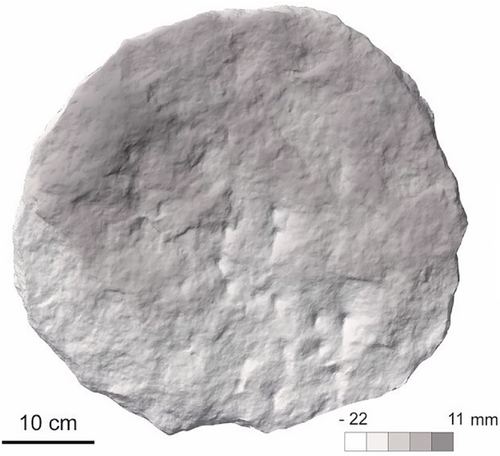You know how some constellations take a little bit of imagination to see? Yes, Leo looks a bit like a lion and Orino a bit like a hunter but then we drift into the realms of powerful levels of imagination to be able to see Pegasus as a flying horse or Telescopium as a telescope! Even squinting or tilting your head really doesn’t make them visible. I found the same problem when looking at images of two stone disks discovered in Italy recently at the entrance to an ancient fort! Teams that have examined the stones have matched the subtle markings on them to positions of 28 bright stars in the sky! I had to really look to see it but I think they might actually be right! The two stones were unearthed in Rupinpiccolo protohistoric (the transition period between prehistory and the earliest recorded history) hill fort in north eastern Italy. There were chisel marks all over the stone and it was suggested that these may form markings to represent bright stars in the night sky.
The marks were thought to be chiselled into the stones and, given that many human cultures seem to recognise the same popular patterns in the stars, it seemed likely that they could be identified. The team employed statistical analysis against known astronomical asterisms with results that showed little error! There were 29 marks on the stone in all and the paper by Paolo Molaro and Federico Bernardini analysed exactly which stars they matched! Nine of them matched the tail of Scorpious, five represented Orion including the stars of the belt, Betelgeuse and Rigel and another nine seemed to correlate with the Pleiades cluster. On the reverse of the disk there was a further five marks that could represent Cassiopeia but there was one mark that couldn’t be explained! The marks did indeed seem to represent all the bright stars in each of the constellations (with exception of Bellatrix and Saiph which may have been eroded) recorded giving credibility to the finding.
A mark slightly north of Orion however has not yet been identified, perhaps it represented a nova or supernova that has not been recorded anywhere else. The mark is close to Mu Orionis which is a pair of physical binaries but also lies close to the location of Epsilon Sagittarii. I must confess though, having read the accuracy to which the marks seem to have been made, the innacuracy of this makes me subscribe to the nova/supernova possibility.
Follow up observations will be needed to test this hypothesis. Whether the stones truly represent the sky will require further analysis. The work of Molaro and Bernardini certainly seem to be pointing to this conclusion but it may be too early to tell, the absence of a couple of prominent stars and the presence of an unidentified object casts a little doubt but 28 marks matching the positions of 28 stars must be far more than just co-incidence.
The marks on the stones are thought to have been made between 1800 and 400 BCE and if they do indeed map to the stars then it must be one of the oldest sky maps ever found. Source : Possible stellar asterisms carved on a protohistoric stone.
From: universetoday
URL: https://www.universetoday.com/165037/an-ancient-stone-found-in-italy-is-an-accurate-map-of-the-night-sky/



